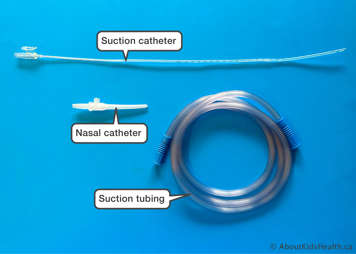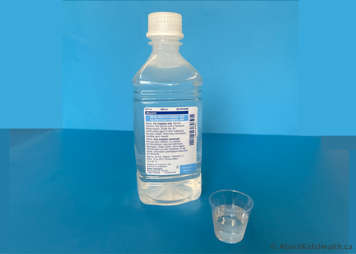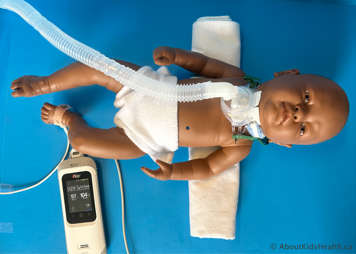
At the end of this chapter, you will be able to:
- understand when to use nasal suctioning
- demonstrate how to perform nasal suctioning

-

Gather your equipment and supplies.
-

Make sure the oximeter is on and provides an accurate reading.
- Have oxygen available (if prescribed for your child).
-

Make sure the suction machine is at the correct setting.
-

Wash your hands well. Parents and caregivers do not need to wear gloves, although you may choose to do so if you have them. If you have a home nurse visiting, they will bring their own gloves and wear them.
-

Fill a clean container with sterile water or saline.
-

Make sure your child is in a comfortable position (laying or sitting).
-

Attach the suction tubing to the correct size suction catheter. Keep the catheter in the packaging until just before use. Do not touch the end of the catheter that will go into your child’s nose.
-

Open the catheter by pushing the base through the paper packaging.
-

You can use water-soluble lubricant, if needed, along the sides of the suction catheter. Avoid using lubricant at the tip of the suction catheter as it can become blocked if too much lubricant is used.
- Before you suction, use a tissue or cotton tipped applicator to clean away visible crusty secretions. This will avoid pushing them back into the nose. You can consider using saline in the nose to loosen dried secretions.
-

Insert the suction catheter into your child’s nostril to the length instructed by your child’s health-care team. The catheter should be aimed backwards and not upwards. Even though the nose looks like it goes up, gently aim the catheter straight back along the bottom of the nose (see picture below). Be careful not to force the catheter. If you meet resistance, try the other nostril. Keep your thumb off the suction control port.
Note: Your child’s health-care team may advise you to only suction the tip of the nares (nostrils) or enter the nose a bit more. Please suction the nose as instructed by your child’s health-care provider.
-


Apply suction by holding your thumb over the suction control port. Slowly remove the catheter. Limit suctioning to five to 10 seconds.
-

Repeat suctioning as needed, allowing at least 30 seconds between suctioning. Alternate nostrils each time you repeat the suctioning. Once you are finished, rinse sterile water or saline through the catheter to flush the tubing well. Discard the catheter and water that was poured.
-

After nasal suctioning, reassess your child’s respiratory status and oxygen needs.
- Turn off the suction unit. Empty and clean the suction drainage bottles and containers, if needed.
- Wash hands well.
- Prepare the suction equipment and supplies for the next use.
Precautions
Do not perform nasal suctioning if:
- your child has had recent nose, sinus or throat surgery
- your child has a bleeding disorder.